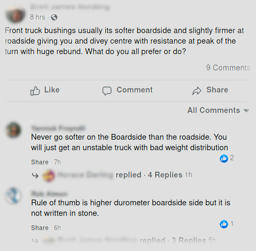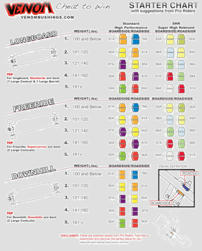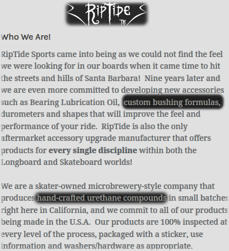In this post, I’ve collected a few topics related to bushings that keep coming up in skate forums. It’s a patchwork of old forum posts.
Wheel-lift
There is essentially one reason why on any given skateboard, after the rider leans a certain amount, one of the trucks stops turning and its hanger just tilts vertically with one of the wheels lifting off the ground: the two trucks of the skateboard have different resistance to the force the rider applies. So, while one truck keeps yielding to the rider’s weight, the other comes to a halt. To remedy this, one needs to balance the bushings (i.e., make them harder for the truck that stays on the ground or softer for the truck that lifts), or one needs to check if something is mechanically blocking the truck from turning (e.g., is the pivot in good condition?). But the overwhelmingly most common cause is the first case: unbalanced bushings (for an explanation, see here). To balance the resistance from the bushings, one can either: 1) lower the angle of the truck that lifts, or increase the angle of the truck that stays on the ground, because this also balances out the trucks’ resistance to the force from the rider, or 2) buy a couple of new bushings with the needed stiffness. (For more on how forces are applied on skateboards, see here.)
Mixing “properties”
You can’t really add bushing properties (if there’s even such a thing) together. A set of bushings is still just two separate bushings stacked together on one truck. If one of the two is more, say, ‘reboundy’, than the other, in the end you’ll have something in-between ‘reboundy’. If one’s hard and the other’s soft, you don’t get “stable yet turny”, that’s logically impossible. Assuming you don’t upset the truck’s geometry, you get a truck as stiff as the mix of the two bushings.
Mixed duros
Why do some people use soft board-side, harder road-side bushings? The idea is that board-side the bushing is compressed also by the rider’s weight. Using a softer one there supposedly balances out the set. I can’t check the veracity of the theory. In my opinion it is a bit far-fetched (because it seems to me a lot more energy is required to compress the bushing lengthwise than from the side), but not illogical either. I wouldn’t bother factoring that in before figuring out the most important thing: the balance between the trucks so that there’s no wheel-lift and so that also my weight is not too big/too small for the bushings.
Some people also do it the other way around (harder board-side), but the logic of it eludes me. In this case, the road-side bushing is clearly compressed/deformed much more than the board-side one. The truck’s hanger is displaced road-side (when there is no spherical bearing keeping it in place), thus upsetting the truck’s geometry. I can’t see other advantages except imaginary ones, as described in paragraph above.
Rider-weight/durometer charts
Bushing companies publish such charts on their websites (like the one in the picture). These are most probably based on randal-type trucks (which is the most common longboard type of trucks) assumed to be mounted flat on the deck, i.e., trucks with a 45°-50° turning axis angle and the kingpin (kp) perpendicular to the truck pivot axis* (p.a.). On TKPs the kp looks like it’s 50°-60° to the p.a. => increase the duro from what the charts recommend. Wedging means less of your weight+centrifugal force on the bushings => decrease the duro.
*the pivot axis of the truck is not always the turning axis (not when wedged for instance)
Sizes
The standard bushing sizes around which, afaik, all trucks are built are .65″ board-side, .55″ road-side (with some exceptions, most notably Bennett Vector). Differently sized bushings can only fit slightly sketchily. Riptide only produces .60″ in this category (source), presumably to save costs (and I can sympathize, but they’re still quite pricey). To fit them you need a washer board-side (which more or less covers the difference) and an over-tightened kp road-side.
Shapes
Why would a similarly shaped but with a different diameter bushing (e.g. cone/fatcone, barrel/chubby) be an option when you want a different resistance from the truck, instead of just changing the bushing’s stiffness? All these different shapes are just a marketing trick, imho.
Brands & Compounds
Generally, I’m skeptical about whether companies are indeed creating their own compounds. Their own molds and shapes, pigmentation and logos, sure. But don’t they still have to buy it in liquid form from somewhere? We shouldn’t be bogged down by one specific brand (more).



